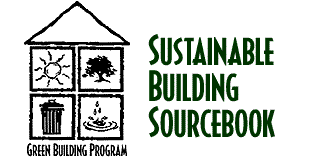
|

|
 |
Check out the Green Building Professionals Directory! |
Recycled-content carpet padding comes in two primary types - from old padding and from reclaimed carpet fibers.
Recycled-content carpeting is made from recycled PET derived primarily from post-consumer plastic soft drink containers.
Natural linoleum is made from softwood powder, linseed oil, pine tree resins, cork, chalk, and jute backing.
Recycled-content tile that is currently available is made from waste glass such as lightbulbs and auto windshields. An additional recycled-content tile is made from a byproduct of feldspar mining.
Natural carpets are those made from grasses, cotton, and wool with minimal treatment.
CONSIDERATIONS:
Common floor coverings are most often cited as primary contributors to indoor air contamination. This is due to the VOC constituents (volatile organic compounds) present in the binders used in the fabrication of the materials such as carpet padding and carpeting and in the adhesives used to apply carpet padding and tile.
Since homes are now constructed tightly in order to conserve energy, chemicals outgassing from building materials are more potent and harmful. Formaldehyde outgassing is a primary threat from commonly-used floor coverings.
Airing a home before it is occupied will dilute the chemicals during their most potent initial stage. However, high levels of VOC's will outgas for months and, in many cases, will continue to outgas for years. Reducing the application of VOC's in the home can be achieved through alternatives - mainly associated with the use of carpeting.
This section identifies recycled-content materials which are durable, high quality, and attractive floor coverings. The use of these materials strengthens the viability of our recycling efforts and greatly benefits our resource and energy impacts.
Linoleum and natural carpets use renewable resources and offer durability without compromising aesthetics. The cork used in linoleum is harvested from the cork tree on an ongoing basis without harming the tree. Along with cotton and wool, carpet-type floor coverings are available from grasses and reeds.
Ceramic tile offers outstanding durability and maintainability. It also has high aesthetic value.
| Commercial Status |
Implementation Issues |
||||||
|---|---|---|---|---|---|---|---|
| Carpet Pad | |||||||
| Recycled Carpet | |||||||
| Ceramic Tile | |||||||
| Linoleum | |||||||
| Recycled Tile | |||||||
| Natural Carpets | |||||||
| Legend | |
|---|---|
| Satisfactory |
|
| Satisfactory in most conditions |
|
| Satisfactory in Limited Conditions |
|
| Unsatisfactory or Difficult |
|
GUIDELINES
Rubber-based recycled padding is quite common. It can outgas. Environmentally sensitive individuals should check a sample of the padding material for any adverse reactions.
Recycled padding from carpet fibers is also available and may be more suitable for environmentally sensitive persons.
A least toxic alternative. Now common in the flooring industry.
Standard application.
Installed similarly to vinyl flooring.
If the backing material is jute, the cuts for seams need to be beveled away from the seam. The jute backing "relaxes" with use and will spread out.
Select installers that have received factory installation training.
Handled like ceramic tile.
Products listed in the Resources section are suitable for high traffic commercial applications.
RESOURCES
PROFESSIONAL ASSISTANCE
Environment Associates
4219 Richmond Ave. Ste 250
Houston, TX 77027-6889
(713) 528-0000
architects experienced in healthy materials
HealthMasters Inc.
P. O. Box 514
New Canaan, CT 06480
(203) 966-3541
architects experienced in healthy materials
Healthy House Institute
7471 North Shiloh Rd.
Unionville, IN 47468
(812) 332-5073
resources/publications
Clint Good
Box 143
Lincoln, VA 22078
(703) 478-1352
architects experienced in healthy materials
Safe Environments
2512 (9th St. #17
Berkeley, CA 94710
(800) 356-2663
(510) 549-9693
resources/publications
Superior Reiser
8816 Schoal Creek Blvd.
Austin, TX 78757
(512) 454-9695
Linoleum; Supplier & installer
CDC Carpets & Interiors
3425 Bee Caves Rd.
Austin, TX 78746
(512) 327-8326
Cork; Supplier & Installer
Intertech Flooring
7303 Burleson Rd.
Austin, TX 78744
(512) 385-4574
Linoleum; Supplier & installer
Austin Fine Floors
1934 Rutland Dr.
Austin, TX 78758
(512) 339-9590
Supplier and installer
Designer Floors of Texas
2400 Braker Lane West
Suite D
Austin, TX 78758
(512) 832-1777
Supplier and installer, wholesale
Forbo Industries
P.O. Box 667, Humboldt Industrial Park
Hazelton, PA 18201
(800) 842-7839
Manufacturer - linoleum
local: Kenmark Inc.(800) 292-1230
Naturlich Natural Home
P O Box 1677
Sebastopol, CA 95473-1677
707-824-0914
Fax: 800-824-4069
http://www.monitor.net./~nathome/
nathome@monitor.net
Dodge-Regupol
715 Fountain Ave.
Lancaster, PA 17601
(800) 322-1932
Manufacturer - cork
Bangor Cork
William & D St.
Box 125
PenArgyl, PA 18072
(215) 863-9041
Southwest Fibers (formaldehyde free)
1100 South McKinney
Mexia, TX 76667
(817) 562-2814
Recycled carpet fibers (manufacturer)
Innovative Interiors
9027 Northgate Blvd.
Austin, TX 78758-6453
(512) 835-1184
Supplier and installer
Dodge-Regupol
715 Fountain Ave.
Lancaster, PA 17601
(800) 322-1932
Recycled tire rubber (manufacturer)
Homasote Company
Box 7240
West Trenton, NJ 08628-0240
(800) 257-9491
(609) 833-3300
Recycled paper (manufacturer)
RR Rubber Products
904 E. 10th Ave.
McMinnville, OR 97128
(800) 525-5530
Recycled tire rubber (manufacturer)
Chris Craft Industrial Products, Inc.
P. O. Box 70, Schoolhouse Lane
Waterford, NY 12188
(518) 237-5850
Recycled and reclaimed fibers - cotton, jute, hemp, acrylics
Dura Undercushions Ltd.
8525 Delmeade Rd.
Montreal, Quebec H4T 1M1
(514) 737-6561
Recycled tire rubber (manufacturer)
Mill Direct Carpet
9505 Burnet Rd.
Austin, TX 78758
(512) 835-4111
Supplier and installer
Spectrum
7112 Burnet Rd.
Austin, TX 78757
(512) 454-7827
Supplier and installer
A/C Custom Windows and Floors
11520 Manchaca Rd.
Austin, TX 78748
(512) 282-3090
Supplier and installer
Image Carpets, Inc.
436 Lavender Dr.
Rome, GA 30165
(800) 722-2504
Manufacturer; supplies throughout US
Innovative Interiors
9027 Northgate Blvd.
Austin, TX 78758-6453
(512) 835-1184
Supplier and installer
Longhorn Carpet Dist (512) 385-3040
Allen's Carpet Handlers (512) 339-4193
Floors of Austin (512) 836-9444
Carpet Gallery (512) 249-8778
Complete Designs (512) 453-5533
Hi-Tech Carpets (512) 834-0110
Carpets by Conrad (512) 280-6210
Designer Floors of Texas
2400 Braker Lane West
Suite D
Austin, TX 78758
(512) 832-1777
Naturlich Natural Home
P O Box 1677
Sebastopol, CA 95473-1677
707-824-0914
Fax: 800-824-4069
http://www.monitor.net./~nathome/
nathome@monitor.net
Dellinger
PO Drawer 273
Rome, GA 30161
(706) 291-7402
Sinan Co.
PO Box 857
Davis, CA 95617-0857
(916) 753-3104
Designer Floors of Texas
2400 Braker Lane West
Suite D
Austin, TX 78758
(512) 832-1777
Sinan Co.(Auro brand)
PO Box 857
Davis, CA 95617-0857
(916) 753-3104
Naturlich Natural Home
P O Box 1677
Sebastopol, CA 95473-1677
707-824-0914
Fax: 800-824-4069
http://www.monitor.net./~nathome/
nathome@monitor.net
AFM Enterprises
350 West Ash St., Suite 700
San Diego, CA 92101
(619) 239-0321
Makes a sealant that blocks toxic fumes from carpets and adhesives.
Franklin International
2020 Bruck St.
Columbus, Ohio 43207
(800) 347-4583
Titebond(R) Solvent -Free(TM) construction adhesive (nearly no VOCs, 5 gm/ltr)
PL Adhesives & Sealants
ChemRex Inc.
889 Valley Park Dr..
Shakopee, MN 55379-1854
(612) 496-6000
"PL Premium" construction adhesive (no VOCs)
Syndesis Studio
2908 Colorado Ave.
Santa Monica, CA 90404-3616
(213) 829-9932
Concrete tiles with a variety of recycled aggregate material, also does countertops and wall panels, material can be worked with wood working tools.
Terra Green Technologies
1650 Progress Drive
Richmond, IN 47374
(765) 935-4760
National Association of Floor Covering Distributors
85 W. Algonquin Rd.
Arlington, VA 60005
(708) 364-9040
US Consumer Product Safety Commission
Room 529
Washington, DC 20207
(800) 638-2772
Toxic Carpet
P. O. Box 399086
Cincinnati, OH 45239
Clearinghouse for information about carpet dangers
return to
 |
 |
 |
 |
| Water | Energy | Building Materials |
Solid Waste |
 |

|

|
|
|
||
Sourcebook Contents | Search Sustainable Sources | Green Building Conferences | Bookstore | Sustainable Building Calendar | Green Building Professionals Directory
This file last updated on Tuesday, August 20, 2002